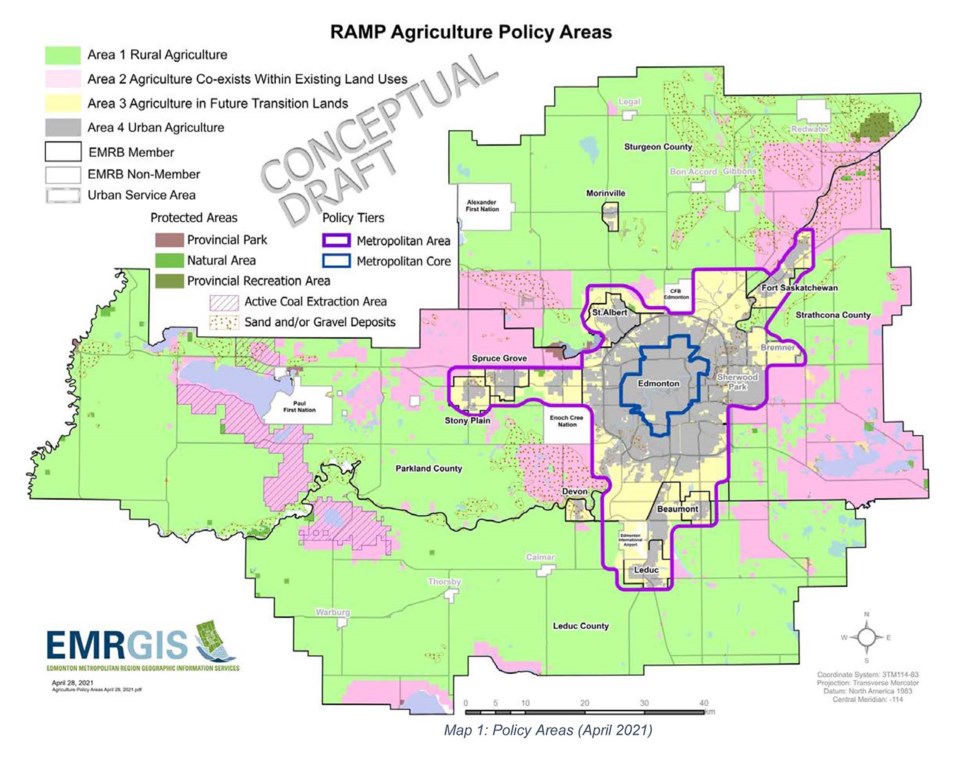Sturgeon County’s mayor wants residents to weigh in on a regional plan that, if approved, would set aside a vast swath of the county’s land for farms and food.
The Edmonton Metropolitan Region Board is hosting six roundtables on its draft Regional Agricultural Master Plan this month, the first of which was June 1.
In development since 2018, the draft plan sets out rules for land use in the Edmonton region, with a view to promote agriculture and preserve top-tier agricultural lands.
Last November, area residents got to weigh in on the draft’s general principals. That led to the current draft, which sets out specific rules for land use and applies them to different parts of the Edmonton region.
This draft sets out the overarching policies for farmland that all area governments were to follow, said Sturgeon County Mayor Alanna Hnatiw (who sits on the agricultural plan's task force). The draft, if approved, would have direct implications for how farmers could subdivide and use their land.
“This is such a broad policy area with far-reaching implications,” she said, both at the regional and hectare-scale level.
Four-colour plan
The plan was meant to protect a stock of prime agricultural land in the Edmonton region so it could become one of the world’s top sources of food, fuel, and fibre, Hnatiw said. That means ensuring said land won’t be built over or fragmented unnecessarily.
The draft plan says the Edmonton region could double its agricultural output by 2044. To promote agriculture, the plan divides the region into four policy areas marked with four different colours on a map.
The draft puts about 63 per cent of the region and almost all of Sturgeon County under Area One, marked in green on the draft’s maps. Farming was to be the number one land use here, with all other land uses (except possibly resource extraction) discouraged. All efforts were to be made to protect and preserve these lands from fragmentation to provide a secure long-term local food source for future generations, and all governments were to pass policies to support agricultural practices here.
These policies mean that a landowner here would not be allowed to convert a farm into to a subdivision or oil refinery, Hnatiw explained. They might be able to turn it into a pulse fractionation plant, as that would be considered complimentary to agriculture.
Tam Andersen of Prairie Gardens & Adventure Farm said she supported the idea of conserving farmland, but was wary of the idea of keeping land in farming indefinitely.
“As a farmer, you invest your life savings into your farm,” she said, and many farmers have their own ideas on how to best use their land.
Andersen said this plan would need robust policies to keep farmers in farming if it were to work, such as supports for value-added industries and ag-tourism.
Area Two of the plan (in pink on the map) covers about 22 per cent of the metro Edmonton region and the southwest, far east, and Sturgeon Valley regions of Sturgeon County. Here, farmland co-exists with other land uses, should not restrict those other uses, and should stay in farming until required for those other uses.
Gibbons-area farmer Wayne Groot said his farm falls in this area. He hoped the plan would flag his region for conservation as farmland in recognition of its unique microclimate and high concentration of potato growers.
“Prime agricultural lands, especially really good land like ours, should always be preserved,” he said.
Area Three (yellow) covered transition lands around places such as St. Albert that are currently farmland but would soon become residential. The draft states that governments were to maintain farming as a complimentary use in this region and ensure farmland was managed through best environmental practices.
Area Four (grey) covered urban agriculture, which is to be governed by municipal urban agriculture plans.
Unanswered questions
Hnatiw said the draft leaves many issues up to future negotiations, including the subjects of compensation, reclamation, and monitoring.
Hnatiw urged residents to read the draft and take its attached survey, as this would likely be one of the last chances they had to weigh in on it.
“I know this is not the ideal time of year,” she said, adding that Sturgeon County criticized the board’s decision to run this consultation when most farmers were busy farming.
“I’m just asking our farmers to understand that this is important work to do.”
Hnatiw said the draft is scheduled to go before the board for approval this August.
Groot said this draft is a good first step, adding it was high time this region talked about protecting its farmland.
“Food production is key to our survival, and protecting good farmland is just a no-brainer in my mind.”
The regional board will hold online roundtables on the draft agricultural plan June 2, 3, 5, 8, and 10 at various times. Visit letstalkramp.ca/ramp-stakeholder-engagement to sign up and view the draft.




